Liuhua Lake: The scenery of early summer, the epitome of Lingnan City Garden, enjoy a short period of lazy and comfortable leisure life
Liuhua Lake Park is located in Yuexiu District, Guangzhou City, adjacent to Guangzhou Railway Station, covering an area of 544,300 square meters. It is a comprehensive park integrating sightseeing, entertainment and leisure functions. It was officially opened to the public in October 1959 and will be open for free since July 2009. Liuhua Lake is named after the Liuhua Bridge, a historic site of the Southern Han Dynasty, to the northeast of the lake. Its water area accounts for two thirds of the park's total area. It is one of the four major artificial lakes in Guangzhou City and still retains the function of flood storage and drainage.
Liuhua Lake Park has subtropical scenery characteristics, mostly palm plants, ficus plants, flowering shrubs and open lawns. The park is divided into three open areas: sightseeing and resting area, entertainment area and flower and bird bonsai viewing area. The main attractions include more than 20 Liuhua West Garden, Frankfurt Garden, Lu Island and Rongyin Amusement Park.

Pu Cuizhou is located on the left side of the south gate, covering an area of 4885 square meters. The area combines Chinese and Western architectural styles and embellishes the garden layout with Lingnan characteristics.
The park's planning and design of the scenic spot is based on the principle of "natural harmony and ecological priority". Landscape elements such as flower stands and watersheds make the entire park space full of romantic artistic conception.


Compared with other parks, Pu Cuiyuan has fewer people and is relatively quiet. Sitting quietly in the leisure pavilion and enjoying the lake view. Looking at the birds in Liuhua West Garden and Lu Island.

In Pu Cui Garden, you can enjoy sycamore, sea pitchnut, mountain fig, autumn maple, hibiscus, camphor, wild peony, nest fern, dog tooth flower, camellia, and golden string of money willow
Wait for plants.

The cedar forest is one of the eight scenic spots in Liuhua,"Red Cloud and Green". It is located at the southern end of the park and covers an area of about 2500 square meters. It is named after hundreds of cedar trees are planted in the scenic area. Tall fir trees are scattered on both sides of the garden road. The leaves of the fir trees are like feathers, and the scenery is different from one season to another. In recent years, the park has set up winding garden roads and ecological rest platforms in the scenic area according to local conditions. Garden plants with rich colors and different shapes are arranged around. The connecting lines between different plants are natural and soft. The imitation wooden plank road along the lake has been added on the bank of the lake., allowing tourists to travel through the forest to have multiple landscape experiences of being hydrophilic, enjoying flowers and enjoying the forest, creating a wonderful place for tourists to get close to nature and absorb oxygen ions.

In spring and summer, green leaves are dancing, fir trees are dressed in new clothes, and new tender green leaves grow on the branches. Walking in this green forest is quiet and fresh, as if you have come to the fairy tale world of "The Wizard of Oz";





Qixian Xuan is next to the Luoyu Pine Forest. The area combines Chinese and Western architectural styles and embellishes the garden layout with Lingnan characteristics. It is quiet and elegant, with a quiet pavilion. Sitting here can enjoy the cool lake wind and touch your tired soul.


Frankfork Garden is located in Liuhua Lake Park in Guangzhou City. Frankfork Garden, also known as the Rose Garden, is a typical German Baroque garden. Built in 1996, it was a city celebration gift from Frankfork City, Germany to Guangzhou City for its 2210 anniversary. It is a historical witness of the friendship between the Chinese and German people. The area of the park is not large and the flow of people is not large, so you can slowly appreciate the flowers.
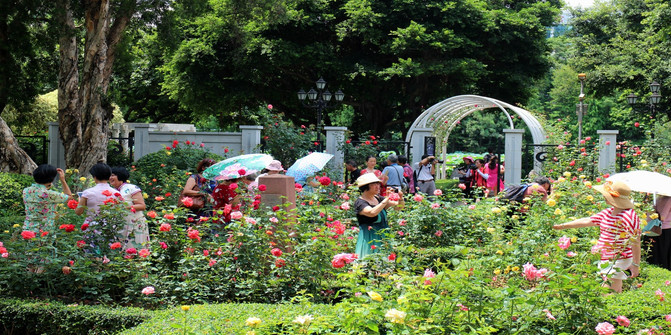
Rosa rugosa Thunb.: Origin in China. It belongs to the order Rosaceae, a deciduous shrub in the family Rosaceae. It has many needle-needles on its branches, odd-numbered pinnately compound leaves, 5-9 small leaflets, oval in shape, with side thorns. Petals obovate, double to semi-double, flowers are purplish red and white, fruit period is August to September, and is oblate. Roses prefer sufficient sunshine, cold and drought-tolerant. They prefer loose and fertile loam or light loam soil with good drainage. They grow poorly in clay loam soil and bloom poorly. They should be planted in places with good ventilation and far away from the walls. The branches are weak, soft, hanging and densely prickly, and they only bloom once a year.

Each rose has a posture. Look at this one, which is slender and graceful, like a beautiful girl; look at that one, which is still a flower bud that looks like it is about to burst. When it is early morning, crystal dew rolls among the leaves and shines in the sun.





The Crape Myrtle Garden covers an area of about 4000 square meters. Various varieties of Crape Myrtle are planted in the courtyard, and about 300 trees are planted. Most of the crape myrtle planted are mainly withered peak bonsai. Although the pile heads are dry and delicate, the branches and leaves are luxuriant, and the crape myrtle flowers are blooming in pieces. When the flowers bloom, the colors of purple, pure white and pink change in a variety and open in the right direction, which is extremely spectacular.

Dry peak type bonsai crape myrtle

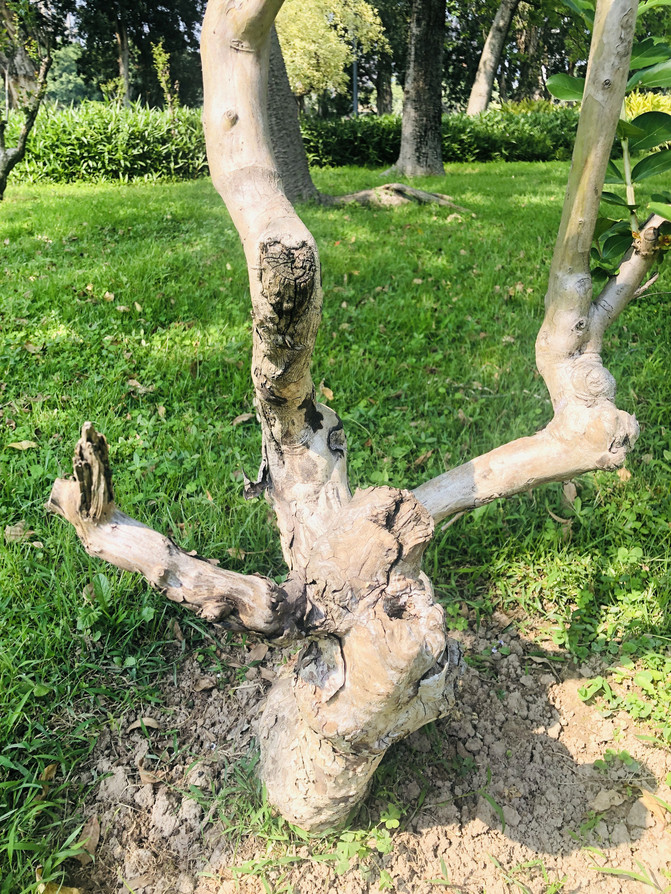
Crape myrtle in early summer

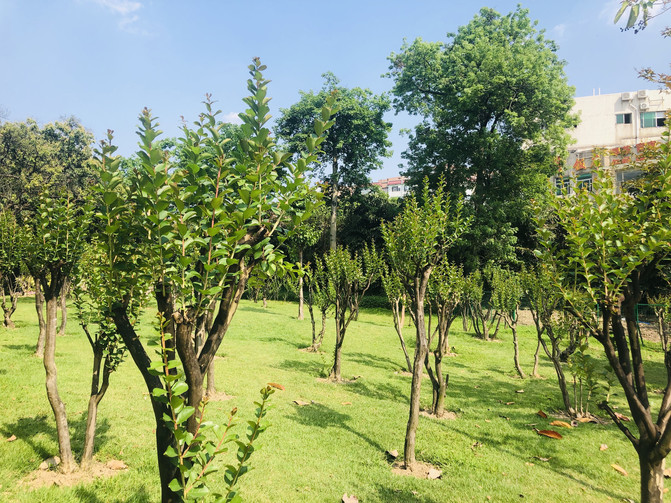

Flowering period from June to September, the crape myrtle tree has a beautiful appearance, smooth and clean trunk, and gorgeous colors; the flowering time is the summer and autumn season with few flowers, and the flowering period is long, so it is known as "a hundred days of red", and it is also known as "summer green covers the eyes, this flower is full of red". It is a good bonsai material for viewing flowers, stems and roots




The lotus pond is next to the crape myrtle garden. During this period, staff in the garden are cleaning up the residual branches and dead leaves of the lotus pond last year. The lotus seedlings have not been planted for a long time, and now only a few lotus leaves can be seen.


Lotus belongs to the Nymphaeaceae of Ranunculales, which is the general name for two species of plants in the genus Lotus. Also known as lotus flower, water lotus, etc. It is a perennial aquatic herb flower of the genus Lotus. The underground stem is long and plump, with long nodes and round leaves. Flowering period is from June to September. It grows alone at the top of the pedicel, with many petals, embedded in the receptacle, and is red, pink, white, purple, etc., or has colorful patterns or borders. Nuts are elliptical and seeds are ovate.
In our country's traditional culture, lotus flowers are not only a beautiful plant with ornamental value, but also endowed with noble moral sentiments by people at that time and are regarded as a "gentleman of flowers."

Wang Changling's "Lotus Picking Song" describes lotus flowers as "lotus leaves and skirts cut in one color, and hibiscus opens to both sides of the face." Li Bai, a poet, also has a praising saying,"Hibiscus grows from clear water, and it is carved naturally."

Yang Wanli's poems about lotus flowers are like "The lotus leaves are infinitely green, and the lotus flowers reflect the sun are particularly red" and "Only the small lotus leaves reveal their sharp horns, and there are dragonflies standing on it." It is even more popular.

Zhou Dunyi, a great scholar in the Northern Song Dynasty, particularly praised his integrity: "I love the lotus to grow out of the mud without staining it, wash it with clear ripples without evil, open the middle and the outside straight, without spreading or branches, the fragrance is far away and clearer, and the pavilions are cleanly planted, so that you can view it from a distance but not play with it.

Yanyu Pavilion is located in the southeast of the park. It is a Han-style water corridor with an elegant and simple design. Together with the surrounding three themed flower landscapes of crape myrtle, roses and lotus flowers, it forms one of the eight scenic spots in Liuhua,"Lotus Pond Misty Rain".

The overall landscape color is simple, elegant, graceful and graceful. The imitation wooden plank road cleverly connects various attractions, integrating the water, flowers and scenery into one. Wherever the pavilion can reach, the drizzle is like a line in the misty rain and rain.

Listening to the sound of the sound of the rain, my heart and the scenery are in harmony, and everything is still. It is like a lotus pond, the misty rain is ethereal, and the sound of the rain is ethereal. The lotus swayed and the fragrance overflowed. The rain splashed on the water, the wind blew the lotus leaves, and the rain fell and the clouds moved, touching thousands of scenery. The lotus pond is misty and rainy, and my heart drops when I see it. The heart is calm and forget the return journey.



Liuhua Yanyu Pavilion is located on the east side of the garden, located along the bank and standing tall by the water. The pavilion is built on the second floor, with green tiles and cornices, making it clear and transparent. The water pavilions are curved corridors and curved bridges are introduced, like dragons swimming in the water. The pavilion is adjacent to crape myrtle and metasequoia. Surrounded by thousands of lotus flowers, clear water and Tsinghua University, you can enjoy the coolness of the south wind.

The sun shines against the rising sun; the shadows are hazy and misty. The long-term cage gauze is as illusory as real. Standing against the railing, with your eyes open, the breeze blowing, and the green water sparkling. In front of me, the red bridge lies across, the pavilion bar hides the shadow, the green trees surround the lake, and the lake lights create shadows. There are both beautiful shadows in the lake, and the boat is leisurely and picturesque!
As far as the pavilion can see, you can see the two islands of Fuqiu and Furong, which are located in the north and south. The green willows on the water sway in the wind, like fantasy smoke, attracting people to explore and search for the fragrance. On the island, willows are dark and flowers are bright, winding paths lead to the secluded scenery, and there is a unique cave. On the occasion of the sunset, there is a setting sun, thousands of lights, the lake and sky are bright, and the floating light jumps over gold, which is amazing. Friends of photography focus on the curved bridge and water pavilion to capture the beautiful scenery that disappears in a vertical direction. It can be said that the sunset is infinitely better and the lake scenery is more beautiful.

As far as the pavilion can see, you can see the two islands of Fuqiu and Furong, which are located in the north and south. The green willows on the water sway in the wind, like fantasy smoke, attracting people to explore and search for the fragrance. On the island, willows are dark and flowers are bright, winding paths lead to the secluded scenery, and there is a unique cave. On the occasion of the sunset, there is a setting sun, thousands of lights, the lake and sky are bright, and the floating light jumps over gold, which is amazing. Friends of photography focus on the curved bridge and water pavilion to capture the beautiful scenery that disappears in a vertical direction. It can be said that the sunset is infinitely better and the lake scenery is more beautiful.


Liuhua Dongyuan Art Expo Hall

Mengyuan is located in the east of the park. It was completed in February 1986. It is one of the earliest gardens built in Guangzhou parks to showcase ethnic customs.


The scenic spot is based on the customs of Dai houses in southwest my country. It has profound meaning and attracts imagination. It is combined with the scattered rocky mountains and ponds, flowing waterfalls, and beautiful flower plants.

Lingbo Path is a lake-facing plank road located on the east side of the park. The plank road follows the trend of the times of health and environmental protection, and is planted with plants of rich colors and different shapes according to local conditions.






Furongzhou Scenic Area is one of the eight scenic spots in Liuhua,"Furong Sanzui". It is located in the north of Liuhua Lake Park. It was built in 1976 and covers an area of about 2100 square meters. It is surrounded by water on three sides and rippling waves. Hundreds of wooden hibiscus trees are planted in the scenic area.

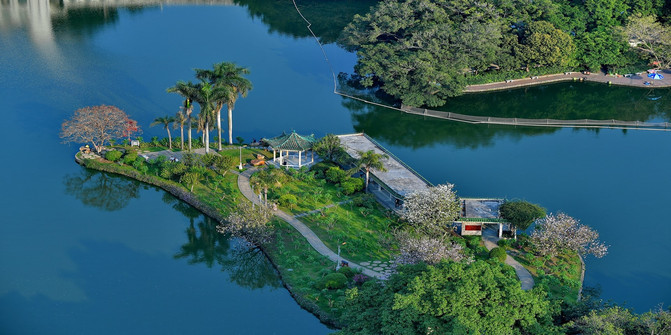






During the flowering season (August to October), hibiscus bloom continuously, reflecting the lake water and attracting attention. A pavilion and corridor building has been built along the water in the continent, with a unique and elegant style. This pavilion and corridor building is the work of Zheng Zuliang, the second-generation architect of Lingnan, in the 1960s. It uses spatial contours to form the framework of the main scenery of Furong Island and has always been regarded as a model of Lingnan garden architecture with local characteristics.




The Hongqiao Kuike is one of the eight scenic spots in Liuhua,"Hongying Kuike". It was built in the late 1950s and is located on the central axis of the park. It is currently the longest, straightest and most distinctive Kuike in Guangzhou City. It is now a historical protected building in Guangzhou City.



The Red Bridge Pavilion was designed and built in October 1959 by Zheng Zuliang, an important architectural activist in modern times in Lingnan and a core figure in the design and construction of modern gardens in Lingnan. There is a horizontal plaque inscribed on the bridge pavilion by Dong Baizhen, a famous Chinese calligrapher: The emerald dancing and flying clouds vividly describe every morning and dusk, the sunflower leaves on both sides fly up and down like two emerald ribbons under the light of the morning and evening light, as if welcoming everyone.




The floating mound is one of the eight scenic spots in Liuhua,"floating mound asking stone". It is located on a small island in the center of the park. It has a narrow terrain and flat terrain. It is surrounded by lake water on all sides, covering an area of about 5000 square meters.



A variety of palm plants are planted in the scenic spot on the island, forming a characteristic garden landscape rich in subtropical scenery. The viewing pavilion corridor, flower rack corridor, and shade plant corridor are integrated into the building, and various flowers and trees are hidden among them, making the building and the environment integrated, with lush trees, green grass, and fragrant flowers flowing, giving people a sense of wide vision, relaxed and happy sensory enjoyment. When you are in it, you can feel the artistic conception of changing scenery and a garden outside the garden. It makes people can't help but have the desire to find out who Fuqiu Gong has worked hard to get rich.






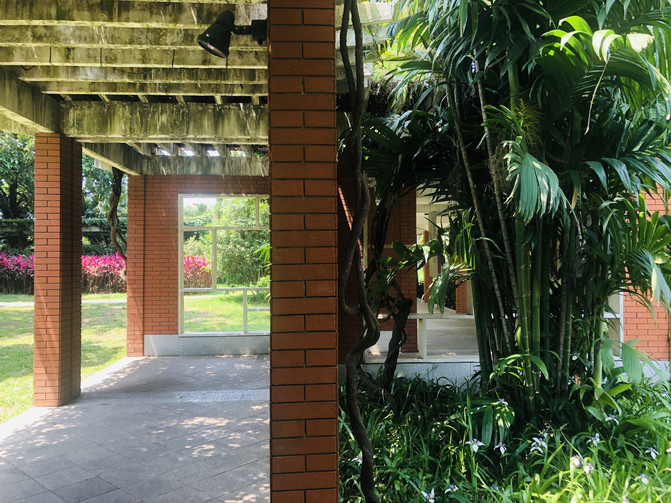

The fitness and entertainment area currently has 32 sets of fitness equipment, such as dual space walkers, single parallel bars, ladders, waist massages, etc., 12 table tennis tables, and 4 rubber-ground badminton courts. The spacious layout of the venue in the area is reasonable and well met the growing construction needs of the people.




Rongyin Amusement Park is located in the northwest of the park, close to Liuhua Road, covering an area of about 9000 square meters. There are more than 30 amusement projects, including Mirage Flying Cars, Corsair Ships, Bumper Cars, Flying Swivel Chairs, etc. It is a comprehensive amusement park with park characteristics. It is a good place for children to play.




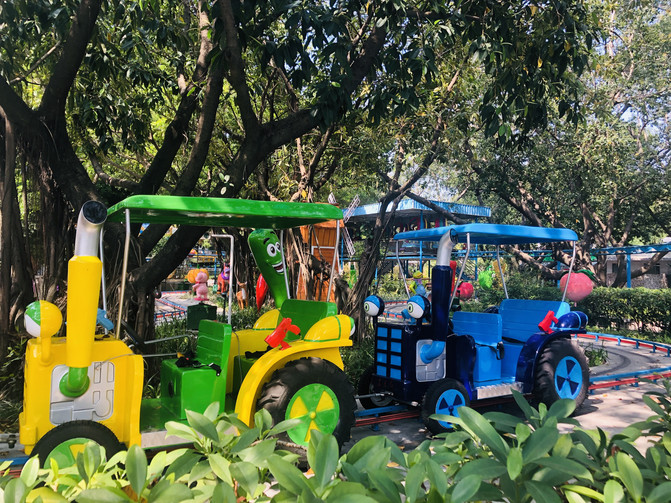



Cruise Department

Guanlu Terrace


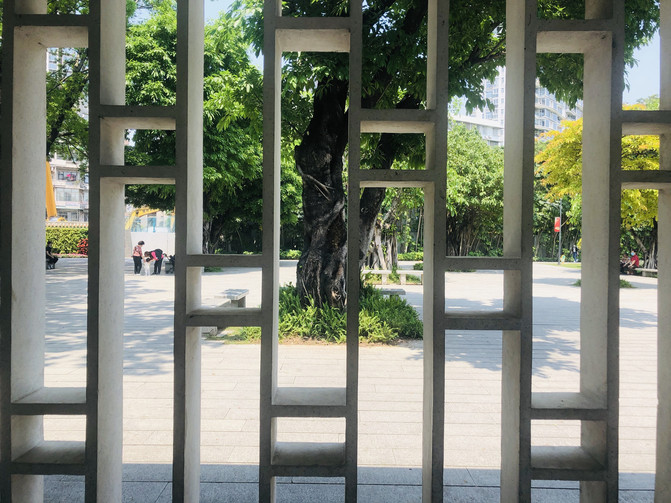




Nongqu Garden is a park with the theme of science popularization. The park has reappearances of farming, fishing, and rural life. Many relatively rare plants are also planted in the park. For example: Golden tea, known as the "Queen of the Tea Family", has the banyan root waterfall in the tropical rainforest, traveler's banana, sparrow flower, honeysuckle...

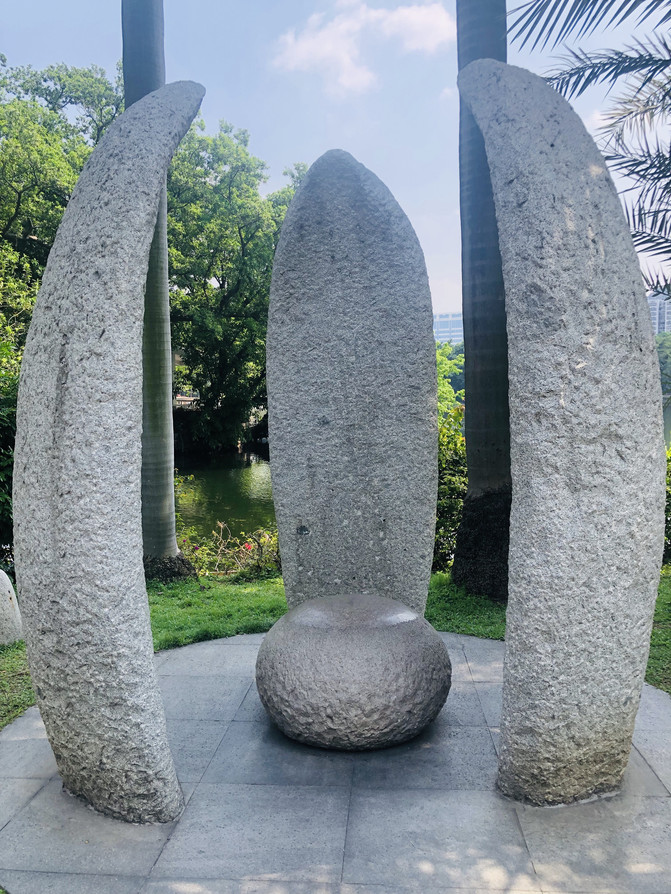
The shady path, on the other side of the path is our Lu Island, where you can watch the "Birds Paradise" up close. Here you can see grey herons, egrets, red-eared bulbul, white-headed bulbul, magpie robins, dark green white-eyed birds, blackbirds, etc. Among them, there are many rare bird species, such as red-billed acacia, white-headed, myna, etc. The world's endangered birds such as Thrushes have become a rare place for citizens and tourists to educate ecological science.


Farmers 'farming scenes in the farming era

Shepherd boy grazing

The civet cat is leisurely basking in the sun. The kittens are not afraid of strangers at all. You can tease them as you please.

Ludao Scenic Area is one of the eight scenic spots in Liuhua,"Silver Herons Flying Together". It is a small island in the center of the lake formed during the lake digging period in Liuhua Lake Park. It covers an area of about 6500 square meters and is surrounded by lake water. Because the island is lush with trees, it attracts many birds, especially egrets, who live here, hence the name "Egret Island". The island was designated as a bird recruitment base by the Guangzhou Regional Green Committee in 1981. After artificial bird recruitment and closed protection, egrets were successfully recruited. Thousands of pairs of birds per mu are shaded. Birds fly in and out every morning and evening. It is spectacular, attracting many tourists to stop and watch, and is known as the "Bird Paradise" in downtown Guangzhou.
Since 1999, the park has made full use of Ludao's unique natural environmental advantages and actively explored the construction of Ludao artificial wetland. After experiencing three stages of continuous practice: self-exploration, expert demonstration, and comprehensive implementation, the construction of Ludao artificial wetland has gradually entered the track of scientific planting and scientific management, and the artificial wetland centered on Ludao has begun to show ecological effects. At present, Lu Island has successfully attracted and gathered a large number of wild birds protected by the state, such as gray herons, egrets, red-eared bulbulls, white-headed bulls, magpie roins, dark green white-eyed birds, blackbirds, etc., among which there are many rare bird species, such as red-billed acacia, pulsatilla, myna, thrush and other world endangered birds, have become a rare place for citizens and tourists to educate ecological science.

Black swans and babies play freely around Lu Island


spotted duck

At noon on Ludao, birds are resting in the trees, but you can still hear the chirping of many birds, and from time to time, birds will fly out of the woods.

Small houses are places for black swans or other birds to rest. There are large areas of forest on Egret Island, mainly made of banyan trees and water-resistant trees from tropical rainforests.


Liuhua Xiyuan is one of the eight scenic spots in Liuhua,"Xiyuan Basin Rhythm". It is located on the west side of Liuhua Lake Park. It was built in 1964 and has a total area of 3 hectares. It is famous for its exhibition of bonsai. Liuhua West Garden enjoys the reputation of "Lingnan Bonsai Home". Most of the bonsai on display in the garden are masterpieces of Lingnan School and works that have won awards in domestic bonsai evaluation activities. Hundreds of bonsai in different shapes are full of fun and fun. The scenery of nature is concentrated between square feet and the big can be seen in the small. Among them, there are many precious shaped varieties of bonsai, such as rare black pine, precious old Podocarpa pine, elm, sparrow plum, Jiuxiang, etc. The oldest ones are about a hundred years old. They have high ornamental value and are popular among the majority of bonsai lovers. Love. There is also an oak tree planted during Queen Elizabeth II's visit to China to symbolize the friendship between China and Britain.



As the saying goes: "Chinese bonsai looks at Lingnan, and Lingnan bonsai looks at Xiyuan." The bonsai of the Lingnan School are in all kinds of shapes, either vigorous and straight, intertwined with roots, or elegant and elegant, with sparse branches and leaves, resembling nature and higher than nature. They are known as "Silent poetry, three-dimensional painting."










After the completion of Liuhua West Garden, Mr. Kong Taichu, the founder of Lingnan Bonsai, served as the technical guidance of the bonsai. Mr. Kong carefully cultivated masterpieces in Xiyuan and passed on his decades of cultivation experience and pruning techniques to future generations, which is of profound significance to the development of Lingnan bonsai art. Now Liuhua West Garden still plants and maintains the bonsai works planted by Mr. Kong Taichu himself.

Liuhuaxiyuan
In the 1960s, Premier Zhou Enlai presented his bonsai work "Spring Repairs to Spring" to the then Ethiopian emperor; during Queen Elizabeth II's visit to China, Xiyuan, in the name of the national leader, presented the Queen with a sixty-year-old nine-scented bonsai, which played a unique role in cultural exchanges between China and foreign countries.

An oak tree was planted during Queen Elizabeth II's visit to China to symbolize the friendship between China and Britain.



Liuhuaxiyuan






Yajing Garden, the small bridge and flowing water in Liuhua West Garden, is the elegant representative of Lingnan Gardens
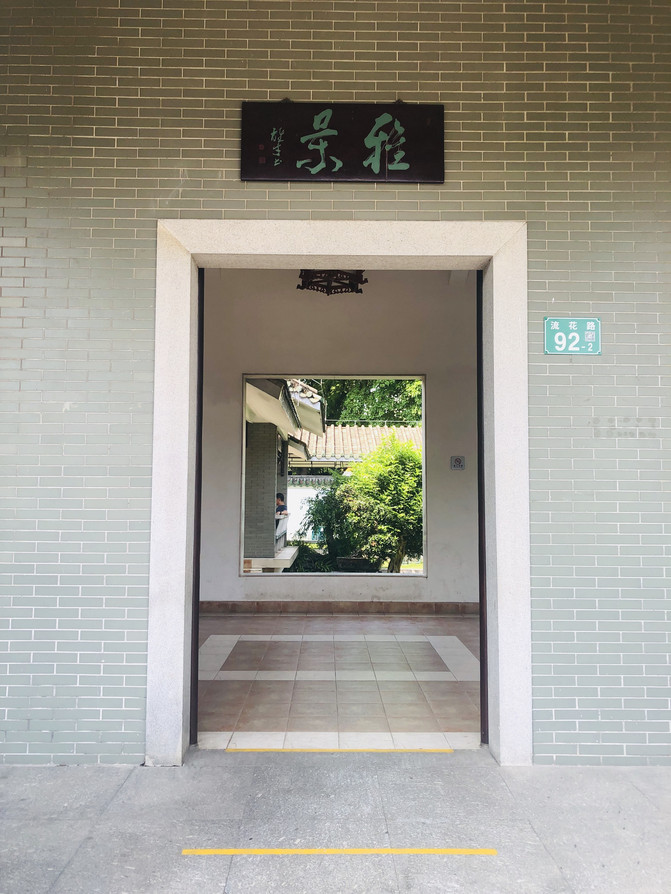
rockery scenery

trickling water

Bonsai display

Lotus pond in the courtyard

Rock decoration








Leisure corridor for people to rest and chat



Unique window view
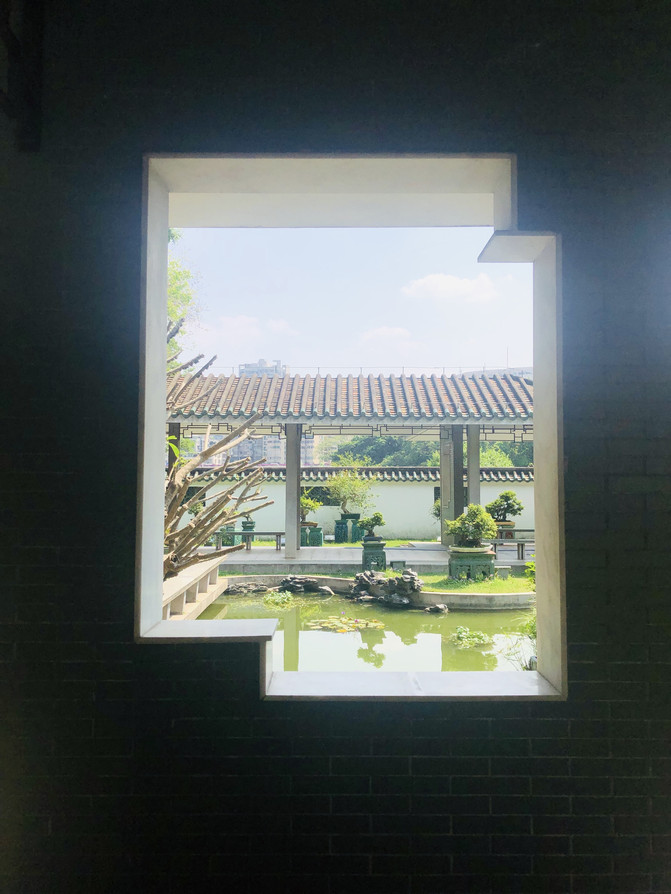
Pu Lin Square is one of the eight scenic spots in Liuhua,"Pu Lin Holding the Moon". It is located in the central scenic area of Liuhua Lake Park and covers an area of about 13000 square meters. It is the largest activity square in the park. Pu Lin Square is integrated with the artistic conception of "Liuhua Sending Love". From the overall shape to the ground paving effect, from the flower pond in the water to the pavement of the square, everything reflects the image of "Liuhua Charm".

The plane effect of the square is like scattered flowers, which is perfectly combined with the winding streams, the flexible stone mountains and waterfalls, and the scattered garden plants, making tourists feel as if they were in the Huanhua River of that year.

Lakeside Leisure Corridor

verdant trees

Shanshi Waterfall

The "Lanyue Pavilion" on the south side of the square serves as the commanding height of the park and provides a panoramic view of the beautiful scenery of Liuhua.
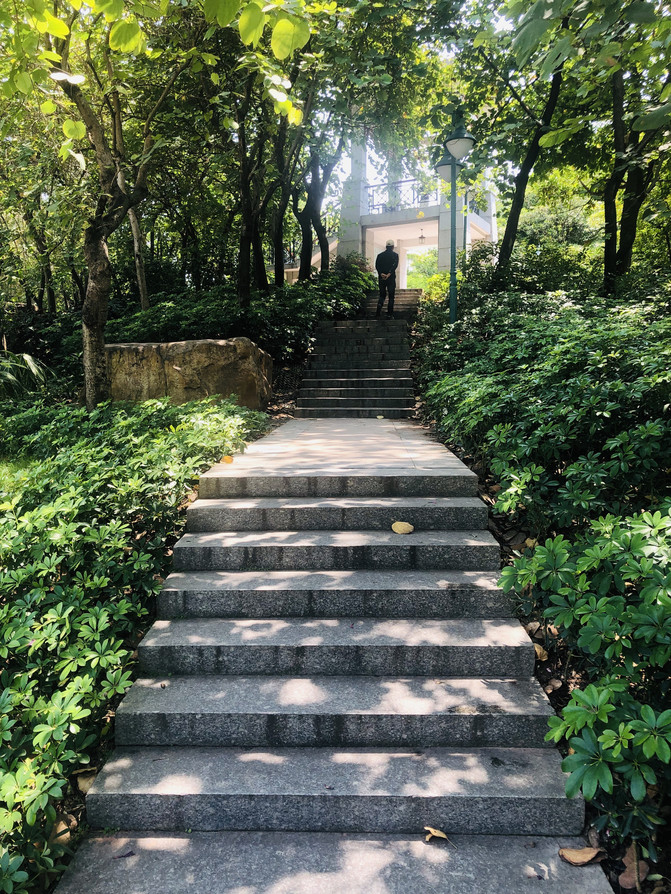


Basically, banyan trees are planted on Rong Island. Here, you can see the scene of banyan root waterfalls in the tropical rainforest.

Rongyin Path

roots of an old tree

Leisure Pavilion

leisure corridor


Banyan Square

Rongdao Bridge

Liuhua Lake Transportation

You can take the following buses to Liuhua Lake Park in Guangzhou City
[Bus] Liuhua Lake Park: 2, 5, 7, 12, 15, 31, 38, 42, 62, 105, 133, 181, 202, 215, 239, 251, 288, 289, 518
2.[Subway] Line 2 Yuexiu Park Station Exit C or D Go straight for 500 meters
(The above routes are for reference only)
3. Self-driving is not recommended
Previous Article:Chapter 3135: Liu Geng Tang He's Grand Ancestral Temple, opening ceremony, dress and apprentice
Next Article:What is the experience of staying in a hotel lit up with "jewel-inspired"?
